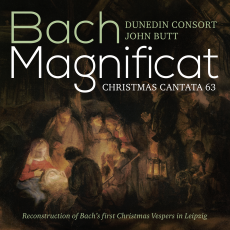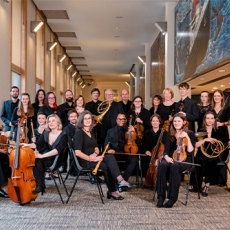Dunedin Consort - J.S. Bach: Magnificat - Fanfare
This release offers John Butt's reconstruction of Bach's first Christmas Vespers service in Leipzig's Nikolaikirche, featuring the Christmas cantata Christen, ätzet diesen Tag (BWV 63) and Bach's original setting of the Magnificat. The Leipzig service would have included a Latin motet, a cantata (presumably the one performed at the morning service at the Thomanerkirche), and after the sermon a Magnificat. Each half of the service would have ended with a congregational chorale, and each element would have been introduced by an organ prelude, perhaps improvised. The cantata sung for Christmas in 1723 was actually composed for Weimar nine years before, but it certainly must have impressed Leipzig with its magnificent scoring (four trumpets!). The Magnificat is equally magnificent. Butt suggests that it may have been composed for the Visitation service in July of 1723, shortly after Bach's instillation as Leipzig's cantor, but it is more commonly thought to have been written for the Christmas service that year. This original Magnificat undoubtedly made an impression on the performers as well as the worshipers because it was set in the key of E?, not the most comfortable key for Leipzig's brass players. It included four interspersed choral interpolations specifically for the Christmas season. A decade or so later he further revised the originally revised work, omitting the four Christmas numbers to make it appropriate for use throughout the church year, while transposing it down a half-step and touching up the scoring. The D-Major version is the one most often sung today, but not, of course, in this reconstruction.
For a motet, Butt has chosen a Christmas motet by Giovanni Gabrieli from Leipzig's archives that must have been known to Bach. Appropriate chorales represent the Leipzig congregation, and a related organ prelude, played by Stephen Farr, introduces each of the vocal components. Missing from the recording, but available as downloads, are the first organ prelude and certain liturgical moments following the Magnificat. Missing from the recording and not available is a sermon, which would have been very long, very German, and in all likelihood three centuries out of line with current mainstream theology. (I believe I made a similar observation about Butt's earlier Good Friday/ St. John Passion reconstruction. Be thankful for small favors.)
In his note, Butt concedes that Bach might actually have used two singers per part, but he uses only one per part anyway. Fortunately his soloists are equal to the task. These are festive works, and Butt's performances vividly transmit the excitement. But in the final analysis I don't believe it is possible realistically to recapture the actual experience of that event. It may-or may not-be able to replicate the music, and Butt's performances may, in fact, better than the ones that took place at the Nikolaikirche in 1723. It's the context, and we, the listeners, that have irrevocably changed. See my comments above about the sermon. So we're left with excellent performances of two amazing compositions-along with a bunch of other interesting stuff. Enjoy them for themselves.
The congregational chorales are sung by 55 persons (not including the soloists) who are listed in the booklet but not otherwise identified. I couldn't help thinking that this non-chorus sounded pretty darned good. And mightn't Bach have doodled a bit at the keyboard as the congregation left the scene?


